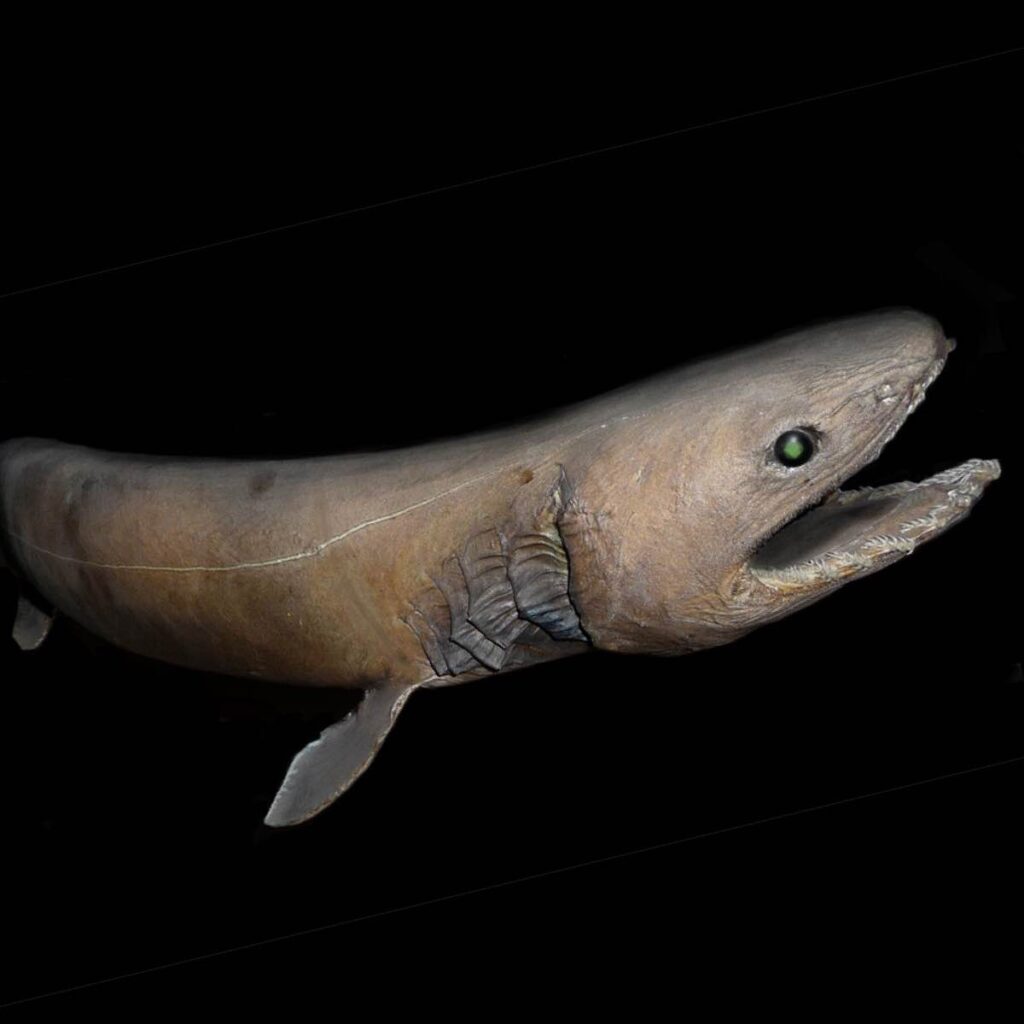Last Reviewed and Updated on March 3, 2023
The frilled shark is a prehistoric-looking deep-sea creature that fascinates scientists and marine enthusiasts around the globe. With a lineage dating back millions of years, this elusive species is considered a “living fossil.” There are many fascinating facts about frilled sharks that are worth exploring; if you are curious about the wonders of the ocean, these facts will thrill you.

About Frilled Sharks
Frilled sharks are a primitive species of shark, considered living fossils, that are found throughout the Atlantic and the Pacific oceans. Their natural habitat is at depths of about 2000 ft / 600 meters.
There are two known living species of frilled sharks:
- the frilled shark (Chlamydoselachus anguineus)
- Southern African frilled shark (Chlamydoselachus africana)
These primitive fish have eel-like body attributes; they are dark brown or gray in color and have long bodies (up to 6.6 ft / 2 m) with dorsal, pelvic, and anal fins located towards the tail. Their gills have a fringed appearance. Frilled shark weight is about 200 pounds / 91 kg on average.
Frilled sharks feed on cephalopods, smaller sharks, and bony fish.
They are aplacental viviparous animals, meaning that they are born of an egg without a placenta connected to the mother shark. The egg develops inside the mother’s uterus, and the infant sharks emerge from the eggs inside the uterus as well. Once the baby sharks are fully developed, the mother gives birth to live young.
The conservation status of both species is regarded as “least concern,” with stable populations in most of their natural range. So luckily, these living fossils aren’t at risk of going extinct.
Interesting Facts About Frilled Sharks
Ready to learn more? Read these fun facts about frilled sharks.

Love weird-looking creatures? Check our list of the strangest animals in the world.
1. They haven’t changed much since prehistoric times
Frilled sharks are considered living fossils as they haven’t changed much since probably first appearing in the seas of at least the Late Cretaceous (95 million years ago) and the Late Jurassic (150 million years ago).
2. They have pairs six pairs of gill slits that have a fringed appearance
Just like other shark species, frilled sharks have gills slits that are individual openings to gills. While most sharks have five pairs of gill slits, fringed sharks have six pairs.
Frilled shark gill slits are covered with gill filaments giving them a fringed appearance which is why these sharks were named frilled sharks.
3. Their livers help with buoyancy in the water
Sharks don’t have a swim bladder and are slightly negatively buoyant, which means they sink if they don’t swim.
Their large, oily liver helps them maintain their position in the water. The oil in the liver is less dense than water, which helps to make the shark more buoyant in the deep waters.
4. The gestation period can be up to 3.5 years long (one of the longest of any animal species)
The gestation period of frilled sharks is not well documented due to their deep-sea habitat and elusive nature. However, based on limited observations of pregnant females, it is thought that the gestation period of frilled sharks is likely to be quite long, in the range of 3.5 to 4 years.
Currently, the frilled shark holds the Guinness world record for the longest confirmed gestation period.
5. Hatched infants in the uterus resemble axolotls
When baby frilled sharks hatch from eggs inside the mother’s uterus, they get their nutrients from the external yolk sacs. At this stage of their life, they visually resemble axolotls.
The Frilled Shark Research Project focused on the embryo development of this shark species, and during their research, some wonderful photographic material was made.
6. Frilled sharks may practice diurnal vertical migration
Diurnal vertical migration (DVM) is a phenomenon in which some marine organisms migrate up and down the water column in a regular pattern over a 24-hour period. This daily migration typically involves organisms moving closer to the surface of the ocean during the night to feed on plankton and then returning to deeper waters during the day.
7. They have 300 trident-shaped teeth

Frilled sharks have a distinctive set of teeth that are well arranged in widely spaced rows (19-28 rows in the upper jaw and 21-29 rows in the lower jaw).
The frilled shark’s teeth are well-suited for capturing and holding onto slippery prey, such as fish and squid, which are common in the deep-sea environment.
8. Frilled sharks have a weak bite
Their teeth and jaw might look menacing, but their bite isn’t really powerful compared to many other shark species.
9. They are capable of devouring really large prey
Frilled sharks are able to devour prey that is larger than their size would suggest in a similar way as gulper eels by using their highly flexible jaws and expandable throats.
10. Research suggests they also hunt by swimming with their mouth open
A captive specimen exhibited this hunting behavior. The frilled shark hunted with its mouth open. The dark-and-light contrast of white teeth and darkness lured the prey into its mouth.
11. Frilled shark was filmed in Japan in 2007 in shallow waters
This shark made the headlines in 2007 as a specimen was filmed in shallow waters in Japan’s Awashima Marine Park. While the sensationalistic titles that accompanied the video weren’t necessary or justified, this truly was a rare sight in shallow waters.
The shark in the video was identified as a female in poor condition, and she died in a matter of hours.
